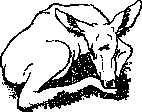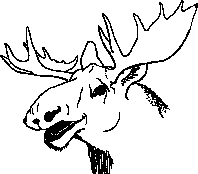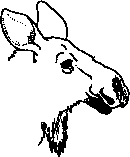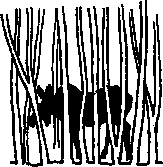| Khltkbr | Projects | Moose | Contents | Previous | Next |

 WHERE TO GO.
WHERE TO GO.
Moose live all over Southcentral Alaska and can be seen most anywhere from downtown Anchorage to the tip of the Kenai Peninsula. Some of the best viewing opportunities are:
Within the Homer Airport Critical Habitat Area in early spring, up to 75 moose may be seen at once as they feed around Beluga Lake. A good place to watch from is the viewing platform at the end of the Calvin and Coyle Nature Trail, which is owned and maintained by Kachemak Heritage Land Trust. Another good spot to view moose is the viewing platform across from the Homer Airport Terminal entrance.
On the lower Kenai Peninsula, wintering moose can be seen along roadsides, but the biggest concentrations are on the lower sections of the Anchor River as well as at the mouth of Fritz Creek and on Beaver Creek Flats. Farther north, the lower elevations and riparian areas of the Ninilchik, Kasilof, and Deep Creek Rivers are important wintering areas with lots of moose.
 The 1969 wildfire burn area along the North Kenai Road is still one of the best moose habitats on the Kenai Peninsula and is an excellent place to see moose at any time of year.
The 1969 wildfire burn area along the North Kenai Road is still one of the best moose habitats on the Kenai Peninsula and is an excellent place to see moose at any time of year.
The Skilak Loop Wildlife Management Area bounded by the Sterling Highway and the Skilak Lake Road is closed to hunting and covers about 135 square miles. It is home to 150 moose in the summer and about 300 in the winter, including some protected bulls whose antlers exceed 60 inches in width.
For those who like to hike, the hills above Skilak and Tustumena Lakes are excellent places to see large bulls and other wildlife in summer and fall. The south side of Tustumena is a good place to see moose in winter.
In early winter, moose migrate through the central Kenai Peninsula, moving down from the uplands towards the lower elevations along the west side. Many stop along the way to take advantage of the new growth coming up in old homestead fields as well as unfenced gardens in the Soldotna and Sterling area.
 Moose can be seen almost anywhere in the Anchorage Bowl. Young calves are common in Kincaid Park. Rutting bulls are safely seen from a distance in the Campbell Creek Valley north of Flattop Mountain.
Moose can be seen almost anywhere in the Anchorage Bowl. Young calves are common in Kincaid Park. Rutting bulls are safely seen from a distance in the Campbell Creek Valley north of Flattop Mountain.
ln spring, moose can be seen wading to get sedge and other emergent plants in wetlands along the Glenn Highway, especially near Spring Creek. During summer, the southern slopes of the Talkeetna Mountains, Wishbone Hill near Sutton, the wetlands along the Knik River and the Swan Lake area are all good places to observe. In winter, the Palmer Hay Flats State Game Refuge and the Point McKenzie area are good places to see feeding moose.
 THE BEST TIMES TO WATCH.
THE BEST TIMES TO WATCH.
Moose can be seen any time, but as any seasoned moose hunter can tell you, at dawn and dusk moose are most active. Move slowly and quietly and try to see the moose before they see you.
 MlND YOUR MANNERS.
MlND YOUR MANNERS.
Moose watching is a very safe activity if you follow a few simple rules and don't step on any bears or porcupines. Mind your manners and keep your distance. A good distance is one where the moose continues to go about its life as if you weren't there. Part of the fun of watching big game is trying not to disturb your prey. Binoculars, spotting scopes, and telephoto lenses allow for viewing and photography at safe distances and provide stress-free experiences for both people and moose.
Being quiet always helps. Many people like to hear the variety of noises a moose can make.
Contents | Previous | Next